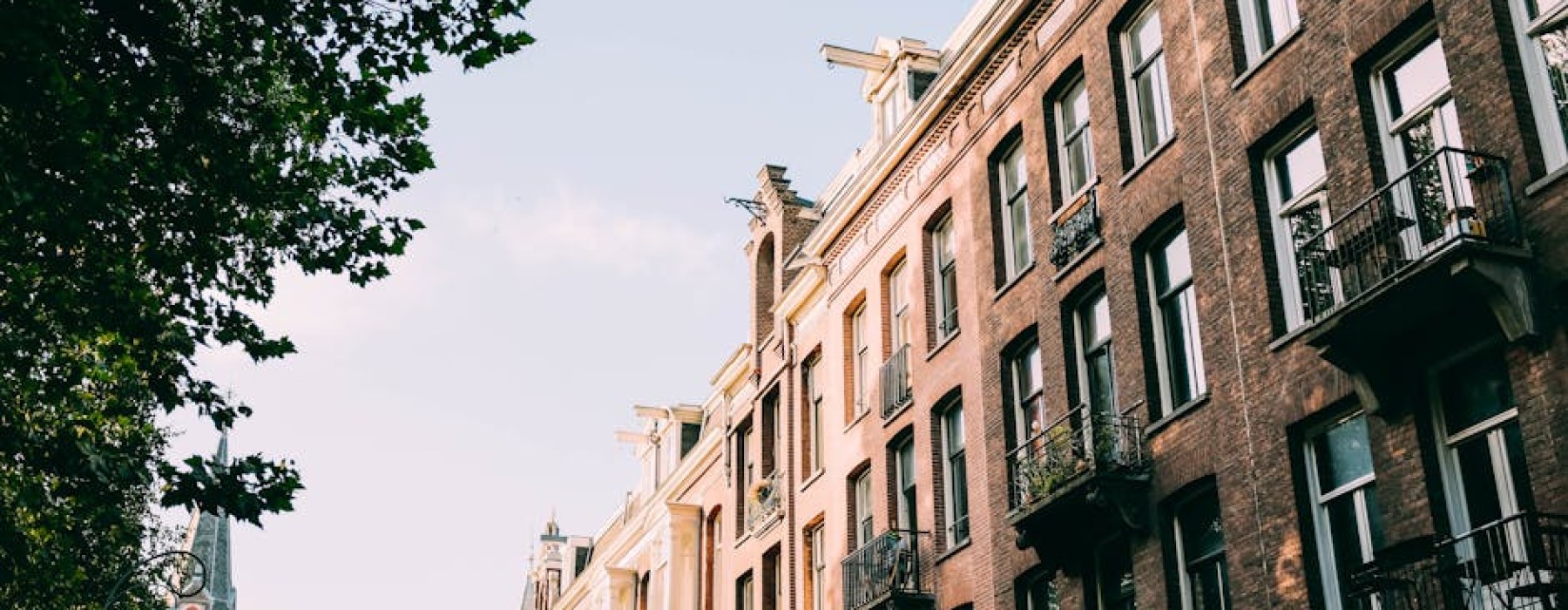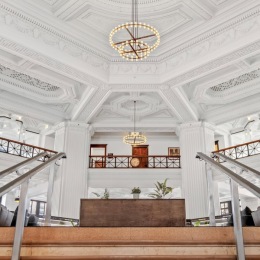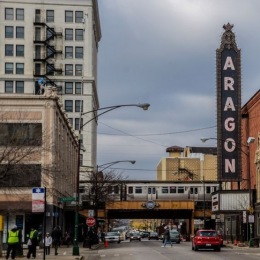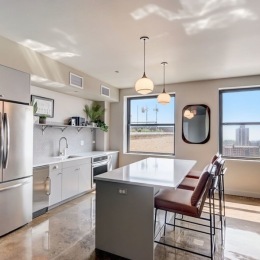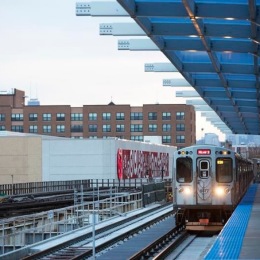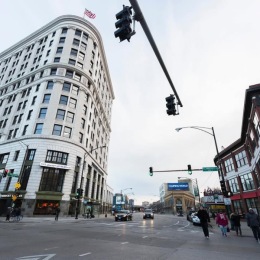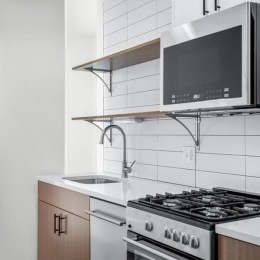Chicago's Architectural Time Capsules: Historic Apartments Worth Exploring
Historic apartments in Chicago offer a distinctive living experience that combines architectural grandeur with modern comfort. These vintage treasures can be found throughout the city, each with unique stories and character.
Key facts about historic apartments in Chicago:
- Most were built between 1880-1940
- Typically feature original details like crown molding, hardwood floors, and ornate fixtures
- Found primarily in Lincoln Park, Uptown, Gold Coast, Hyde Park, Lakeview, and Edgewater
- Often include unique architectural elements like bay windows, stained glass, and ornate facades
- Many have been thoughtfully updated with modern amenities while preserving historic charm
Chicago's historic apartment buildings stand as testaments to the city's architectural heritage and innovative spirit. From the skeleton-frame construction of the 1893 Brewster Apartments to the Beaux Arts grandeur of the 1923 Belden-Stratford, these buildings offer more than just housing—they provide a tangible connection to Chicago's past.
"From the moment you enter this grand, historic Chicago high rise you'll be captivated by its stunning beauty," notes one property description, highlighting the emotional appeal these buildings hold for many residents.
Unlike cookie-cutter modern developments, historic apartments often feature irreplaceable craftsmanship: intricate woodwork, leaded glass windows, vintage tile, and architectural details that would be prohibitively expensive to recreate today. Many buildings have fascinating histories as former hotels, schools, or even factories that have been thoughtfully repurposed for modern living.
While vintage charm comes standard, most historic buildings have been updated with contemporary conveniences like high-speed internet, updated kitchens, and modern HVAC systems—creating the perfect blend of old-world character and new-world comfort.
What Makes an Apartment "Historic" in Chicago?
When you hear "historic apartments in Chicago," it's not just clever marketing—it's a term with real meaning and character. Chicago's vintage residences tell stories through their walls, windows, and woodwork that new buildings simply can't match.
The City of Chicago's landmark ordinance officially protects buildings with significant architectural, historical, or cultural value. But here's the thing—not every charming pre-war building has that official gold star. Many beautiful vintage apartments built before World War II share those same lovely characteristics without the formal designation.
Generally speaking, the "50-year rule" serves as a useful guideline. Buildings that have stood for at least half a century might qualify for historic consideration. That said, the most treasured apartment buildings in Chicago's landscape often date back much further—to the late 1800s and early 1900s.
I love walking past adaptive reuse projects—those former schools, factories, and hotels transformed into unique living spaces. These thoughtful conversions preserve our architectural heritage while creating homes that meet modern needs. There's something special about living in a space with a previous life and purpose.
When you step into a historic apartment in Chicago, you'll likely notice several telltale features:
- Radiator heat that creates that cozy, enveloping warmth
- Original hardwood floors with character and patina
- Generously high ceilings (often 9+ feet)
- Crown moldings and decorative plasterwork that frame rooms beautifully
- Built-in bookshelves and cabinetry crafted by skilled hands
- Stained or leaded glass that paints with light
- Facades with details you could study for hours
- Formal dining rooms for proper entertaining
- Charming sunrooms or sleeping porches
- Original tile work in bathrooms and kitchens with vintage appeal
The architectural styles vary wonderfully across the city. You might find yourself drawn to the symmetry and classical details of Beaux Arts buildings, the geometric patterns and bold colors of Art Deco, the intricate details of Victorian Gothic, the horizontal lines of Prairie School, or the innovative structural elements of Chicago School architecture.
More info about Historic Apartments Chicago
Historic Apartments in Chicago—Key Criteria
What truly makes an apartment "historic" in Chicago? It comes down to several important elements:
First, the build date matters significantly. Most historic apartments in Chicago were constructed during the city's major building booms between the 1880s and 1940s, with the greatest concentration from 1911-1929—a golden age for apartment architecture.
Then there's the original craftsmanship that simply can't be replicated today. These buildings showcase hand-carved woodwork, plaster details created by artisans, mosaic tile floors laid piece by tiny piece, and metalwork forged with techniques rarely practiced now.
Many historic apartments boast architectural significance through their connection to renowned architects like Daniel Burnham or respected firms such as Meyer Fridstein, whose visions shaped Chicago's distinctive skyline.
Buildings with landmark protections enjoy both benefits (like potential tax incentives) and responsibilities (restrictions on certain modifications, particularly to exteriors). This balance helps preserve Chicago's architectural heritage for future generations.
Finally, the historical context adds another layer of significance. Buildings that played important roles in Chicago's development or housed notable figures connect residents to the city's rich social and cultural history.
Together, these elements create living spaces with depth, character, and stories that newer buildings—for all their conveniences—simply cannot match. When you live in a historic apartment, you're not just a resident; you're a steward of Chicago's architectural legacy.
Guide to Chicago's Most Iconic Historic Apartment Buildings
Chicago's skyline tells a story of architectural innovation, with countless vintage buildings now offering unique living spaces. Let's explore some of the most captivating historic apartments in Chicago that combine timeless design with modern living:

The Brewster Apartments (1893)
Step inside 2800 N. Pine Grove Avenue and you'll find yourself mesmerized by the Brewster's breathtaking central atrium. This Chicago Landmark features incredible cast-iron staircases that spiral upward, ornate railings that showcase period craftsmanship, and innovative glass-block walkways that filter light through multiple floors. As one of Chicago's earliest residential high-rises, the Brewster pioneered skeleton-frame construction techniques—the same approach that would later make Chicago's famous skyscrapers possible.
The Belden-Stratford (1923)
Originally known simply as "The Belden," this Lincoln Park treasure boasts 450 units wrapped in stunning Beaux Arts Second Empire style. Listed on the National Register of Historic Places, its design draws direct inspiration from French palaces—walking through its public spaces feels like stepping into a miniature Versailles. Before its conversion to luxury apartments, this former hotel welcomed luminaries from Gloria Swanson to Louis Armstrong through its grand entrance.
Hotel St. Benedict Flats (1882)
Despite what its name suggests, this architectural gem was never actually a hotel—the clever naming was simply a legal workaround of its time. Built in 1882 at Chicago and Wabash Avenues, it introduced wealthy Chicagoans to "French flats" (luxury apartments) following the Great Chicago Fire. Look up to appreciate its distinctive mansard roof, or admire the decorative lintels and original art glass windows that have survived nearly 140 years.
Webster House (1919)
This stately 14-story Lincoln Park high-rise began life in 1919 as a hotel catering to Chicago's elite. Converted to apartments in the late 1970s, residents enjoy direct views of Lincoln Park Zoo, the Conservatory, and Lake Michigan. What makes Webster House particularly special is its commitment to housing diversity—it maintains a federally subsidized Section 8 waiting list, making historic living accessible across income levels.
Lawrence House (1928)
Uptown's Lawrence House stands as a testament to thoughtful restoration. Built in 1928 as a luxury apartment hotel, today's residents walk across original terrazzo flooring, swim in a pool with restored mosaic tiling, and gaze up at a spectacular skylight that floods common areas with natural light. Modern amenities blend seamlessly with historic elements—where else can you find a 6,000-square-foot fitness center with both a vintage pool and a boxing ring?
Stewart School Lofts (1907)
Imagine living in your old elementary school—but much cooler. This 1907 schoolhouse has been transformed into unique luxury lofts where residents enjoy exposed brick walls, preserved chalkboards, and original hardwood floors that once hosted generations of students. Each apartment tells a different educational story while providing thoroughly modern comforts.
3240 N Lake Shore Drive (1920s)
Privacy comes standard in this 1920s lakefront gem, with just two units per floor. The building's concrete floors and substantial brick and plaster walls create a peaceful environment rarely found in newer construction. Floor plans range from cozy studios to sprawling six-bedroom units—some exceeding 4,000 square feet for those seeking truly expansive historic living.
Co-ops on Lake Shore Drive
Chicago's cooperative apartment movement flourished between 1911 and 1929, resulting in magnificent pre-war buildings along Lake Shore Drive. These distinguished addresses feature grand floor plans often including formal dining rooms and former maid's quarters (now perfect home offices). Many welcome residents through lobbies that wouldn't look out of place in European châteaux, setting the tone for neat living from the moment you arrive.
Historic Apartments in Chicago—Architectural Showpieces
What makes historic apartments in Chicago truly special are the architectural innovations and craftsmanship that simply can't be replicated today:
The ingenious light-sharing design at the Brewster uses glass blocks in floors to illuminate lower levels—a creative solution to the lighting challenges of early high-rise living. The introduction of French flats forever changed how wealthy Chicagoans viewed apartment living, changing it from a necessity to a luxury lifestyle choice.
Many of these buildings began as residential hotels, complete with doormen, dining rooms, and maid service—explaining their unusually spacious layouts and grand common areas. The architectural principles pioneered in these residential buildings directly influenced Chicago's commercial skyscrapers, making them living laboratories of architectural innovation.
From hand-painted ceiling beams to imported stone floors, these buildings showcase artisanal skills that have largely disappeared from modern construction. Each doorknob, light fixture, and decorative element tells a story of craftsmanship that connects residents to Chicago's rich architectural heritage every day.
Neighborhoods & Architectural Styles Map
Historic apartments in Chicago aren't evenly distributed across the city's landscape. Instead, they cluster in distinctive neighborhoods, each with its own architectural personality and vintage apartment character.

Lincoln Park
Stroll through Lincoln Park and you'll find yourself enchanted by tree-lined streets showcasing everything from charming vintage walkups to grand pre-war buildings like the Belden-Stratford and Brewster Apartments. The neighborhood offers exceptional walkability, putting residents just steps from the actual Lincoln Park, its beloved zoo, the lush conservatory, and the sparkling lakefront.
Uptown
Once the beating heart of Chicago's entertainment scene, Uptown houses an impressive collection of historic apartment buildings with stories to tell. Gems like Lawrence House and Stewart School Lofts stand as testaments to the neighborhood's rich architectural heritage amid ongoing revitalization. Here at The Teller House Apartments by Flats®, we're proud to continue this tradition, having lovingly transformed a historic bank building into luxury apartments that honor Uptown's past while embracing modern comfort.
Hyde Park
Home to the prestigious University of Chicago, Hyde Park boasts stately vintage apartments, many constructed for the 1893 World's Columbian Exposition. Walking these streets, you'll spot the distinctive influences of Academic Gothic and Prairie School architecture at every turn.
Gold Coast
This affluent lakefront enclave showcases luxury pre-war co-ops and neatly converted hotels along Lake Shore Drive. These distinguished buildings often welcome residents with ornate lobbies, attentive doormen, and breathtaking lake views that capture Chicago's majestic skyline.
Edgewater
This welcoming lakefront neighborhood offers charming vintage apartments in smaller, more intimate buildings. Many feature delightful courtyard layouts and Prairie-influenced designs that create cozy community spaces.
Lakeview
A vibrant mix of vintage walkups and larger pre-war buildings defines Lakeview's historic apartment landscape. Look for distinctive bay windows and decorative stonework as you explore. Residents enjoy excellent transit access via the Red and Brown Lines, making city exploration a breeze.
Logan Square
Known for its graceful boulevards and distinctive Greystone buildings, Logan Square offers vintage apartments with Prairie and Arts & Crafts influences that won't break the bank. The neighborhood's historic character remains wonderfully intact despite its growing popularity.
Styles You'll Spot Block-to-Block
Wandering Chicago's neighborhoods reveals a fascinating architectural story told through distinct styles:
Prairie School designs catch the eye with their horizontal lines, overhanging eaves, and organic motifs – the legacy of Frank Lloyd Wright and his creative circle. Chicago School buildings, pioneered by visionaries like Louis Sullivan, showcase rational designs with thoughtful ornamentation and innovative structural approaches that changed architecture forever.
Look up to spot terra-cotta ornament – elaborate decorative elements in baked clay featuring everything from classical figures to nature-inspired designs. Distinctive cornices crown many pre-war structures, while bay windows create three-sided projections that flood interiors with natural light while adding character to building exteriors.
| Neighborhood | Common Architectural Styles | Notable Features | Landmark Density |
|---|---|---|---|
| Lincoln Park | Beaux Arts, Queen Anne | Bay windows, ornate facades | High |
| Uptown | Art Deco, Spanish Revival | Theater district influence | Medium-High |
| Hyde Park | Gothic Revival, Prairie | Academic influence | Medium |
| Gold Coast | Beaux Arts, Second Empire | Luxury details, doormen | High |
| Edgewater | Prairie, Craftsman | Courtyard buildings | Medium |
| Lakeview | Classical Revival, Victorian | Walkups, greystones | Medium |
| Logan Square | Greystone, Arts & Crafts | Boulevard system | Medium-Low |
Living in a Historic Apartment: Perks, Quirks & Modern Upgrades
There's something special about coming home to a space with stories to tell. Living in a historic apartment in Chicago means embracing both timeless charm and distinctive character that simply can't be manufactured.

Perks of Historic Living
When you step into a vintage Chicago apartment, you'll immediately notice the difference. Those thick, plaster walls don't just showcase beautiful craftsmanship—they create naturally quieter living spaces where you're less likely to hear your neighbors' conversations. The distinctive character shines through in original woodwork, vintage tile patterns, and architectural details that tell stories of another era.
Many residents fall in love with radiator heat, which provides a consistent, enveloping warmth that feels different from modern forced-air systems. Those soaring 9-12 foot ceilings create an airy, spacious feeling that makes even modest square footage feel generous and grand.
Beyond the physical space, there's often a stronger sense of community in historic buildings. Residents tend to share an appreciation for their building's heritage, creating natural conversation starters in the elevator or mail room. Plus, most historic apartments are nestled in established neighborhoods with mature trees, walkable amenities, and cultural institutions just steps away.
Quirks to Accept (or Address)
Of course, vintage living comes with its own soundtrack. Those beautiful hardwood floors might creak and squeak as you cross the room—a charming reminder of age for some, though it might take getting used to. Similarly, steam radiators have their own symphony of gentle hisses and occasional clanks as they heat up and cool down.
Window drafts can be a challenge in older buildings, though many have installed storm windows or energy-efficient replacements. And if you're a clotheshorse, you might need to get creative—pre-war apartments were built when people owned far fewer possessions, so closet space tends to be more limited.
The floor plans themselves often include charming but unexpected features: butler's pantries, breakfast nooks, or sunrooms that might require some creativity to furnish. And while most buildings have updated their electrical systems, you might find fewer outlets than in brand-new construction.
Modern Upgrades in Historic Settings
The good news? Most historic apartments in Chicago have been thoughtfully updated to meet contemporary expectations. Energy-efficient window retrofits improve comfort while maintaining the building's historic appearance. Many vintage buildings now offer thoroughly modern conveniences like keyless entry, smart thermostats, and building-wide Wi-Fi networks.
In-unit laundry has been cleverly incorporated into many historic apartments, tucked into closets or kitchen spaces. Kitchens have been updated with modern appliances and finishes while preserving architectural integrity. And buildings like The Teller House have transformed historic spaces into contemporary amenities like fitness centers and co-working lounges.
Ownership Types: Co-op vs. Condo vs. Rental
When exploring historic apartments in Chicago, you'll encounter different ownership structures, each with its own character:
Co-ops represent Chicago's first form of apartment ownership (1911-1929). Rather than owning your unit directly, you purchase shares in a corporation. These buildings often feature more stringent approval processes and financial requirements, but frequently offer more gracious floor plans and established community standards.
Condos are individually owned units with a deed, common in converted vintage buildings. Owners pay monthly assessments for building maintenance and common areas, creating a different financial structure than traditional rentals.
Rentals remain the most accessible option for experiencing historic living. Many grand old buildings operate as traditional rental apartments, either in their original form or thoughtfully converted from hotels or other uses.
Each type creates different financial implications, maintenance responsibilities, and community dynamics worth considering.
Budget Check: Vintage vs. New Construction
Contrary to what many expect, historic apartments in Chicago often provide excellent value compared to new construction. Vintage units typically offer more space for your dollar, with generously proportioned rooms and those coveted high ceilings that make everyday living feel more neat.
Many historic buildings include heat in the rent thanks to central boiler systems, simplifying your monthly budget. Vintage buildings also tend to have less dramatic seasonal price fluctuation than newer luxury developments, creating more stability for long-term residents.
While Chicago doesn't have rent control, many vintage buildings maintain more consistent pricing than the newest glass-and-steel towers. At The Teller House Apartments by Flats®, we've found our residents deeply appreciate the value proposition of historic luxury—spacious floor plans with character and craftsmanship that new construction simply can't replicate, all at competitive rates.
Finding & Leasing Historic Apartments in Chicago
Hunting for the perfect historic apartment in Chicago feels a bit like a treasure hunt—one that rewards those who know where to look and what to ask. While modern high-rises dominate rental listings, the city's vintage gems often require a more specialized approach.

When searching online, try using the "built before" filter on rental sites, targeting pre-1940 or pre-1950 construction dates. The magic words that often signal a historic property include "vintage," "pre-war," "classic," and "character" in the descriptions. Buildings with storied pasts—former schools, factories, banks, and hotels—often make for the most unique living spaces.
Focusing your search in neighborhoods known for their architectural heritage can save time. Lincoln Park, Uptown, Hyde Park, Gold Coast, Edgewater, and Lakeview all boast significant concentrations of historic buildings. Walking these neighborhoods can sometimes yield findies that never make it to online listings—many vintage buildings still advertise vacancies the old-fashioned way, with window signs or banners.
What many apartment hunters don't realize is that historic living isn't exclusively for the affluent. Several vintage buildings maintain waiting lists for subsidized apartments, making these architectural treasures accessible across income levels. Webster House Apartments, for example, accepts Section 8 vouchers with a regularly opening waiting list.
What to Ask Before Leasing
When you step into that charming pre-war lobby, the ornate details might sweep you off your feet—but don't let romance cloud practical considerations. Smart questions can prevent future headaches when leasing a historic apartment in Chicago:
About heating systems: "When was the boiler last replaced?" Steam and hot water radiator systems are common in vintage buildings, providing that distinctive winter warmth many residents love, but aging systems can cause issues.
About comfort and efficiency: "Have the walls been insulated? Are there storm windows or replacements?" Original windows may be beautiful but drafty, while thoughtful upgrades can preserve character while improving comfort.
About safety considerations: For pre-1978 buildings, inquire about lead paint remediation. Many historic buildings have addressed this issue during renovations, but it's always worth confirming.
About modern conveniences: "Has the electrical system been updated? Are there enough outlets for today's tech-heavy lifestyle?" Many vintage apartments have been rewired to accommodate modern needs, but capacity varies widely.
About plumbing: Water pressure and pipe materials matter in older buildings. Ask if galvanized pipes have been replaced with copper or PEX.
About sound transfer: Those thick plaster walls often provide excellent soundproofing, but floor-to-ceiling transmission can vary. Ask current residents about noise levels if possible.
About building history: Sometimes the quirkiest question yields the most useful information: "Why did the previous tenant leave?" The answer might reveal persistent maintenance issues or confirm that it was simply a job relocation.
Chicago Historic Apartments for Rent
Quick List of Search Resources
Finding your perfect historic apartment in Chicago becomes easier with these specialized resources:
Domu stands out as a Chicago-specific rental site with excellent vintage apartment listings, while Property Rocks frequently features unique historic properties with character. Don't overlook neighborhood-specific Facebook groups, where locals often post vacancies before they hit major platforms.
For inspiration, consider taking a Chicago Architecture Center tour to identify buildings and neighborhoods that speak to your aesthetic preferences. Management companies that specialize in historic properties, like Flats®, often maintain multiple vintage buildings and understand the unique maintenance needs these treasures require.
Sometimes the best approach is simply lacing up your walking shoes and exploring neighborhoods in person. Many of Chicago's most beautiful vintage buildings rely on location-based advertising rather than digital listings—a "For Rent" sign in a window might lead you to your dream apartment.
At The Teller House Apartments by Flats®, we understand the special connection people feel to historic spaces. Our own change of a landmark bank building into luxury apartments in Uptown Chicago represents our commitment to preserving architectural heritage while creating comfortable, modern homes. Whether you choose our community or another historic gem, Chicago's vintage apartments offer living experiences as unique as the city itself.
Frequently Asked Questions About Historic Apartments in Chicago
Are landmarked buildings harder to renovate?
The short answer is: it depends on what you're changing. Landmark status primarily affects the outside of the building—if you want to modify facades, windows, or structural elements, you'll need approval from the Commission on Chicago Landmarks. The good news? Interior renovations usually face fewer restrictions unless specific indoor features are also officially landmarked.
For renters, landmark status rarely becomes an issue since property owners handle all renovation approvals. If you're buying a condo or co-op in a historic building, you might face some limitations on replacing windows or adding balconies, but these restrictions often come with property tax benefits that help balance things out.
Here at The Teller House Apartments by Flats®, we've steerd the landmark process successfully, preserving our building's historic character while creating thoroughly modern living spaces inside.
How do radiator-heated units compare on utilities?
Many historic apartments in Chicago come with radiator heating systems powered by central boilers. The best part? In buildings with these central systems, heat is typically included in your rent or assessment, eliminating separate heating bills altogether.
Radiator heat brings several advantages that modern systems can't match:
- Consistent, enveloping warmth even during Chicago's brutal winters
- No uncomfortable drafts like you get with forced air systems
- Maintains natural humidity levels, avoiding the dry air issues common with newer HVAC
- Often more reliable and longer-lasting than contemporary heating systems
The main drawback is that some vintage buildings offer limited temperature control, though many have installed thermostatic radiator valves that let you adjust comfort levels in individual rooms.
For summer cooling, window air conditioners remain common in vintage buildings, though some renovated properties have added central air or sleek ductless mini-split systems that preserve architectural integrity.
Where can I find affordable vintage units?
While some historic apartments in Chicago come with luxury price tags, plenty of affordable options exist if you know where to look:
Venture beyond the lakefront neighborhoods to places like Rogers Park, Albany Park, or Pilsen, where vintage buildings often offer historic character without the premium prices. Smaller two-flat and three-flat buildings typically provide vintage charm without doorman services or fancy amenity costs that drive up rent.
Some historic buildings maintain affordable units through various housing programs—it's worth asking leasing agents about these options. Emerging neighborhoods undergoing revitalization often have beautiful historic buildings with competitive pricing as they attract new residents.
Consider units with vintage kitchens and baths that haven't been fully updated—they often rent for less than renovated units while still offering the high ceilings, hardwood floors, and architectural details that make historic apartments special.
In our experience at The Teller House Apartments by Flats®, historic apartments frequently provide better value per square foot than new construction, especially for those who appreciate architectural character and craftsmanship over brand-new finishes.

Conclusion
Historic apartments in Chicago offer far more than four walls and a roof—they provide a living, breathing connection to the city's rich architectural legacy. When you walk through the ornate lobby of the Brewster or gaze up at the Beaux Arts elegance of the Belden-Stratford, you're experiencing Chicago's innovative spirit firsthand.
Choosing vintage living means embracing a certain delightful duality. Yes, your floors might creak a bit, and you'll grow accustomed to the gentle hissing of radiators in winter. But these quirks come packaged with irreplaceable craftsmanship—soaring ceilings, intricate woodwork, and architectural details that simply can't be replicated in today's construction.
The beauty of Chicago's historic apartment landscape lies in its diversity. You might find yourself drawn to the academic Gothic influences in Hyde Park, the converted warehouse spaces of the West Loop, or perhaps a classic pre-war walkup in Lincoln Park. Whatever your preference, there's a piece of Chicago's architectural story waiting for you to become part of it.
Here at The Teller House Apartments by Flats®, we take immense pride in continuing this tradition of thoughtful preservation. Our change of a historic Uptown bank building honors its architectural significance while creating thoroughly modern living spaces. Step outside our doors, and you're moments away from iconic theaters, vibrant restaurants, and the cultural richness that defines Uptown.
We invite you to explore Chicago's historic neighborhoods and find these architectural treasures for yourself. Tour the buildings, walk the streets, and imagine yourself living within walls that have witnessed decades of Chicago history. When you choose a historic apartment in Chicago, you're not just selecting a place to live—you're becoming a steward of the city's architectural heritage and writing your own chapter in its ongoing story.
More info about our neighborhood guide

